Does Cat Socialization Require Special Training or Skills?
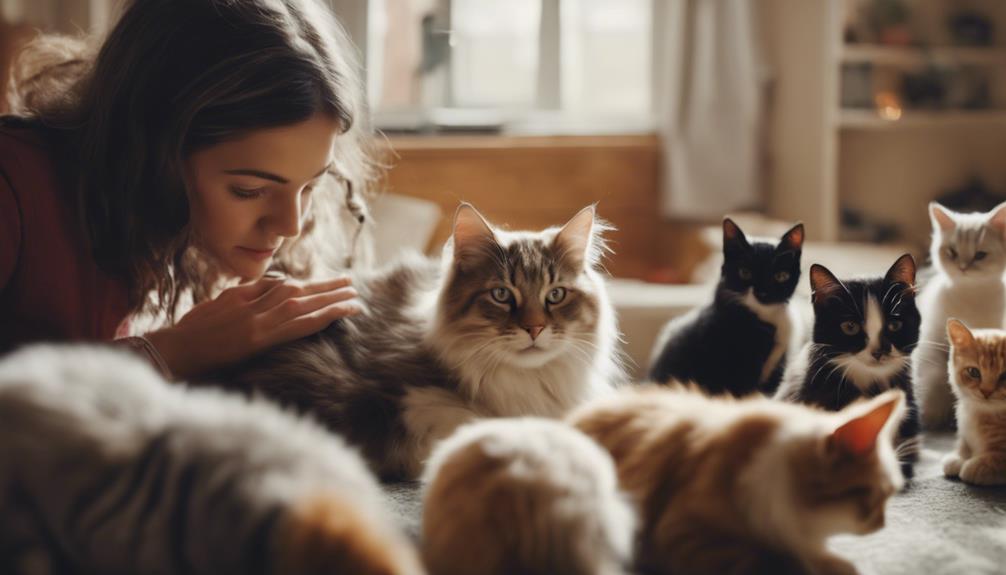
Cat socialization is the process of helping cats adapt to living with humans and other animals. It is important to start socialization when the cat is young, as it can be more challenging to socialize an older cat. Some tips for successful cat socialization include providing a safe and comfortable environment, giving the cat time to adjust to its new surroundings, and using positive reinforcement techniques such as treats and toys to encourage good behavior. Additionally, it is important to be patient and consistent in your efforts to socialize your cat, as it may take time for them to become comfortable with their new environment and companions. By following these tips and techniques, you can help ensure a smooth and successful socialization process for your cat.
Cat socialization can also involve introducing your cat to other pets in the household. It is important to introduce cats to other animals gradually and in a controlled environment to prevent conflicts. Some techniques for introducing cats to other pets include using scent swapping, allowing the animals to interact through a barrier, and supervising their interactions closely. By taking the time to properly introduce your cat to other pets, you can help prevent aggression and ensure a harmonious relationship between your animals.
Remember that every cat is unique, and the socialization process may vary depending on the cat's personality and past experiences. By being patient, consistent, and understanding of your cat's needs, you can help them adjust to their new environment and build positive relationships with both humans and other animals.
Overall, successful cat socialization requires time, patience, and a willingness to understand and work with your cat's individual needs and preferences. By following these tips and techniques, you can help ensure a smooth and successful transition for your cat into their new home.
Benefits of Cat Socialization
When properly socialized, cats develop healthier behaviors and stronger bonds with their human companions. Cat training benefits include reduced aggression, increased confidence, and improved litter box habits. Socialization techniques play a crucial role in achieving these positive outcomes. By exposing cats to various stimuli in a controlled environment, such as different people, animals, sounds, and textures, they learn to adapt and become more comfortable in different situations. This exposure helps prevent fear-based behaviors and encourages social interactions.
Additionally, socialized cats are more likely to be well-adjusted, confident, and less stressed in new environments. They're also easier to handle during veterinary visits or grooming sessions. Cat training benefits extend to fostering better communication between the cat and its owner, leading to a more fulfilling relationship. Engaging in interactive play, positive reinforcement, and setting consistent boundaries are essential components of effective socialization. Ultimately, investing time in socializing a cat pays off by creating a harmonious and enriching bond between the cat and its human family.
Understanding Cat Behavior

An understanding of cat behavior is essential for cat owners to ensure a harmonious relationship with their feline companions. Understanding feline behavior can help owners interpret their cats' actions, needs, and emotions more effectively. Below is a table summarizing some common feline behaviors and their potential meanings:
| Behavior | Description | Possible Meaning |
|---|---|---|
| Kneading | Kneading with paws | Contentment or comfort |
| Purring | Producing a vibrating sound | Happiness, relaxation, or seeking attention |
| Tail Puffing | Fluffy tail | Fear or agitation |
| Slow Blinking | Slow, deliberate blinking | Sign of trust and affection |
Building Trust With Your Cat

Building trust with your cat is a gradual process that requires patience and consistency from the owner. Cats are sensitive animals that respond well to routines and stability. To build trust, it's essential to establish boundaries early on. This can be achieved by creating a safe space for your cat where they can retreat when feeling overwhelmed. By respecting their boundaries and giving them time to adjust to new environments or situations, you show your cat that you're a trustworthy companion.
Consistency is key when building trust with your cat. Regular feeding times, play sessions, and grooming routines help create a predictable environment that your cat can rely on. Avoid sudden changes in their schedule or environment, as this can cause stress and erode the trust you've built.
Introducing Cats to New Environments
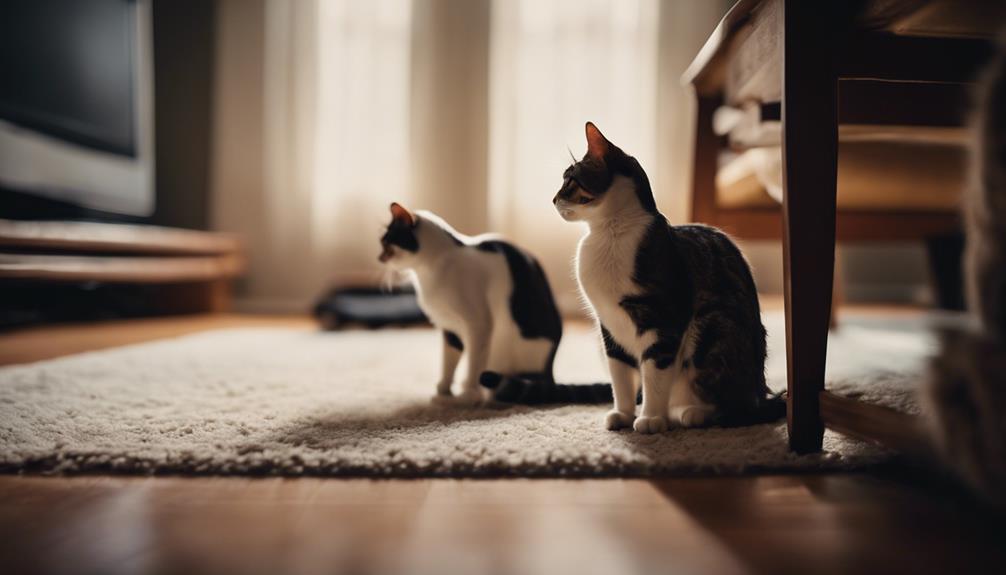
When introducing cats to new environments, it's crucial to employ environment familiarization techniques to help ease their transition.
Additionally, transitioning multiple cats into a new space requires careful planning and consideration of each cat's unique needs.
Safety measures for integration should be implemented to prevent conflicts and ensure a smooth adjustment period for all feline companions involved.
Environment Familiarization Techniques
Introducing cats to new environments requires gradual exposure and positive reinforcement to help them feel comfortable and secure in their surroundings. To expand a cat's comfort zone, it's essential to introduce them slowly to the new environment. This can be achieved by allowing the cat to explore one small area at a time, gradually increasing the space available to them.
Familiar scent introduction is also crucial in helping the cat feel more at ease. Placing items with familiar scents, such as bedding or toys, can provide a sense of security. By incorporating these gradual exposure techniques and introducing familiar scents, cat owners can assist their feline companions in acclimating to new environments with patience and care.
Transitioning Multiple Cats
To facilitate a smooth adjustment for multiple cats in new environments, owners can utilize gradual exposure techniques and familiar scent introductions to promote a sense of security and comfort among the feline companions. When transitioning cats to a new environment, it is essential to consider their social dynamics and individual personalities. Below is a table outlining some key strategies for introducing multiple cats to a new space effectively:
| Transitioning Multiple Cats | Description | Purpose |
|---|---|---|
| Gradual Exposure | Slowly introduce new spaces | Reduce stress and anxiety levels |
| Familiar Scent Introductions | Swap bedding or toys between cats | Establish familiarity and comfort |
| Separate Safe Spaces | Provide individual safe zones | Allow cats to retreat if needed |
Safety Measures for Integration
In ensuring the safe integration of cats into new environments, owners should prioritize establishing a structured introduction process. Safety precautions are essential during this period to prevent conflicts and ensure a smooth transition.
Gradual integration is key, allowing the cats time to adjust to their new surroundings and potential housemates. Supervision is crucial to monitor interactions and intervene if necessary. Patience is vital as cats may need time to acclimate and establish their hierarchy.
Providing separate spaces initially, with gradual supervised introductions, can help reduce stress and potential conflicts. By implementing these safety measures and being attentive to the cats' behaviors, owners can facilitate a successful integration process and help their feline companions feel comfortable in their new environment.
Socializing Cats With Other Pets
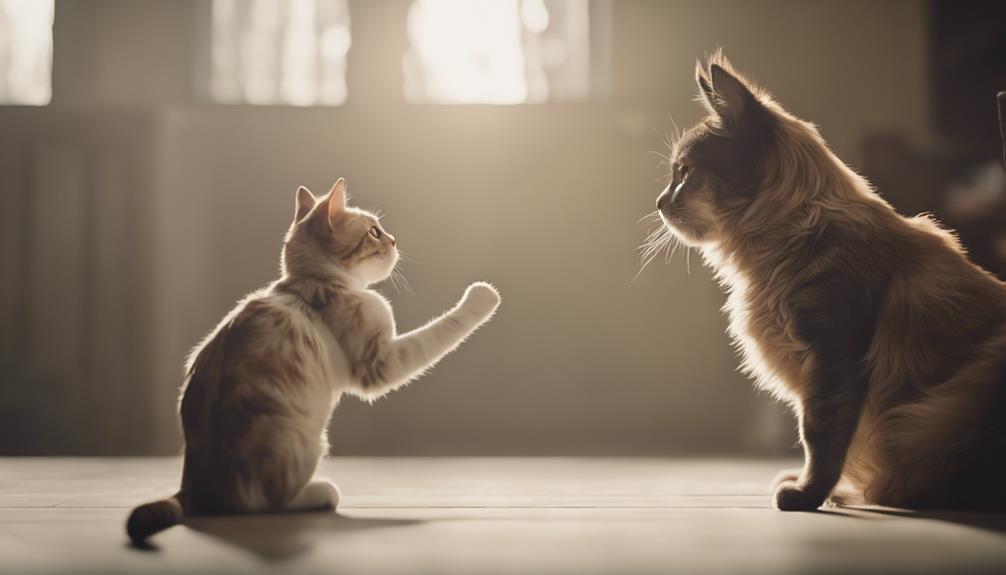
When introducing cats to other pets, such as dogs, it's crucial to proceed with caution and allow for gradual interactions to prevent potential conflicts.
Understanding cat-cat interactions involves observing body language, vocalizations, and territorial behaviors to gauge compatibility and establish harmony within the household.
Managing dynamics in a multi-pet household requires a balanced approach that considers each animal's individual needs and preferences to foster positive relationships and minimize stress.
Cat-Dog Introductions
Introducing cats and dogs can be a gradual process that requires patience and careful observation. Understanding dog-cat dynamics is crucial when bringing these pets together.
Start by keeping them separated and gradually introducing their scents through toys or blankets. Once they seem comfortable, allow them to see each other from a safe distance. Supervise their interactions closely, watching for signs of stress or aggression.
Positive reinforcement, like treats or praise, can help create a positive association. Reward calm behavior and give each pet their space when needed. Feline-canine relationships can vary greatly, so it's essential to be patient and let them set the pace.
With proper introduction techniques and socializing tips, cats and dogs can learn to coexist peacefully.
Cat-Cat Interactions
Understanding the dynamics of cat-cat interactions is essential for successfully socializing cats with other pets. When introducing a new cat to your household, observing their body language and play interactions is crucial. Cats communicate through their body language, so being able to interpret signs of fear, aggression, or relaxation is key to facilitating positive interactions. Play interactions between cats can help establish bonds and relieve stress, but it's important to monitor these play sessions to ensure they don't escalate into fights. Encouraging parallel play where each cat has their space but can still see and smell each other can help build familiarity and comfort. Below is a table summarizing common cat body language signals:
| Body Language Signal | Interpretation |
|---|---|
| Ears flattened | Aggression or fear |
| Tail up, relaxed | Contentment |
| Purring | Happiness or relaxation |
| Hissing | Fear or aggression |
Multi-Pet Household Dynamics
How do cats interact with other pets in a multi-pet household, and what dynamics are at play when socializing them together?
In a multi-pet household, establishing a pet hierarchy is crucial for harmonious coexistence. Cats may use various forms of feline communication, such as body language, vocalizations, and scent marking, to navigate their relationships with other pets. Understanding these communication cues can help pet owners facilitate positive interactions between their cats and other animals in the household.
It's essential to provide each pet with their own space, resources, and attention to prevent conflicts and ensure they feel secure. By observing and respecting each pet's boundaries and preferences, pet owners can create a peaceful environment where all pets can thrive together.
Overcoming Socialization Challenges
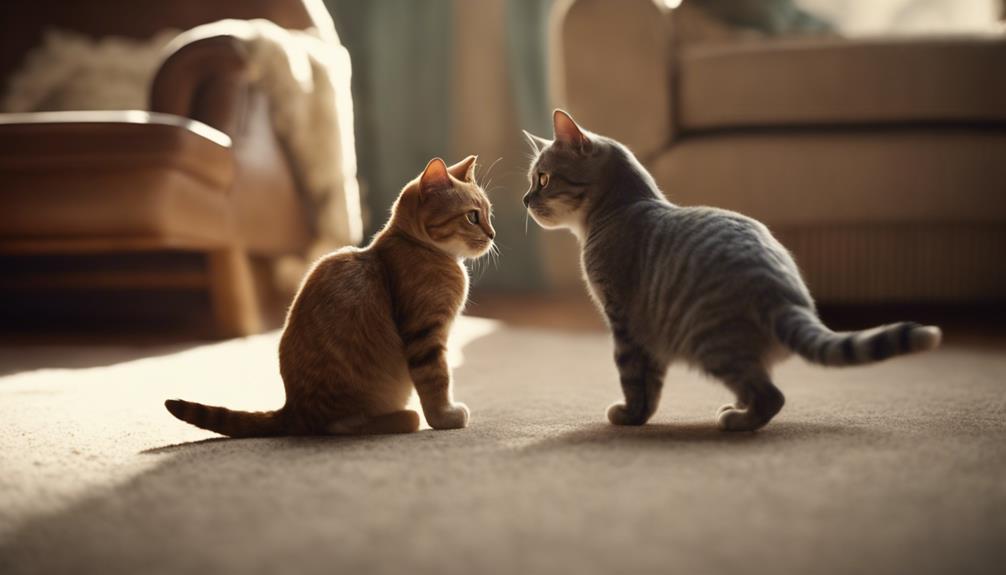
When faced with challenges in socializing a cat, patience and consistency are key elements in helping the cat adapt to new environments and interactions. Challenges such as fear, aggression, or shyness can be overcome through various socialization techniques. One effective method is desensitization, where the cat is gradually exposed to the source of fear or discomfort in a controlled and positive way. This helps the cat build confidence and reduce anxiety over time. Another technique is counterconditioning, which involves pairing the feared stimulus with something enjoyable like treats or play to create a positive association.
Consistency in applying these techniques is crucial for success. It's important to establish a routine and provide a safe, comfortable space for the cat to feel secure. Slowly introducing new experiences and individuals can also help the cat become more socialized. Seeking guidance from a professional, such as a veterinarian or animal behaviorist, can be beneficial in navigating specific challenges and tailoring a socialization plan to suit the cat's individual needs.
Maintaining Positive Cat Relationships
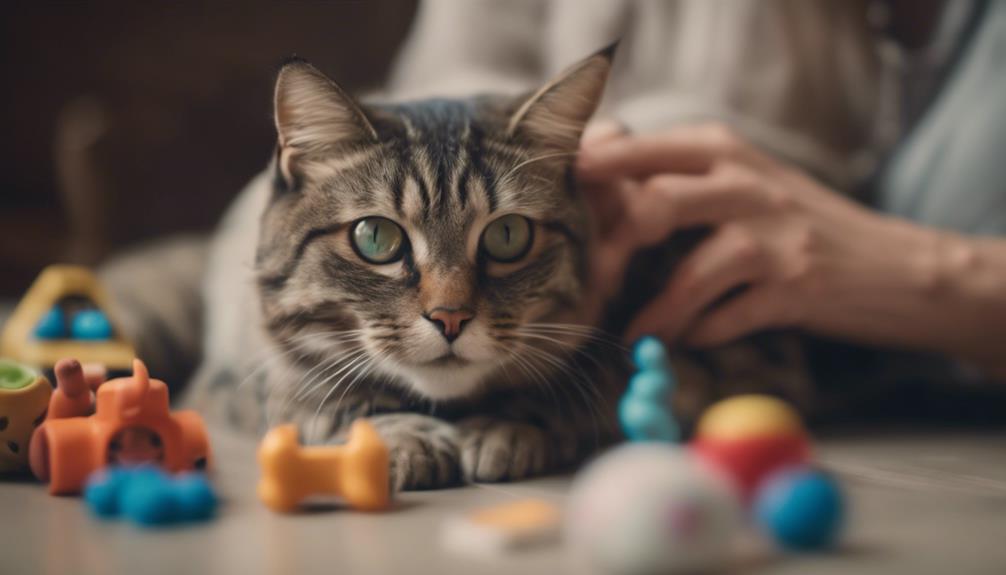
To ensure positive cat relationships, consistent and positive interactions are essential for fostering trust and companionship between cats and their owners. Understanding behavioral cues and engaging in social interaction play crucial roles in maintaining a harmonious bond with feline companions. Cats communicate through various signals, such as body language, vocalizations, and even facial expressions. By paying close attention to these communication signals, owners can better comprehend their cats' feelings and needs, thus building trust over time.
Trust building is a gradual process that requires patience and empathy. Cats appreciate routines and consistency, so maintaining a stable environment can help strengthen the bond between them and their owners. Providing a safe and comfortable space, regular feeding times, and interactive play sessions can enhance the quality of the relationship. Moreover, respecting a cat's boundaries and allowing them to initiate social interactions can contribute to a positive and mutually satisfying companionship. By prioritizing the well-being and emotional needs of their feline friends, owners can cultivate lasting and fulfilling relationships with their beloved pets.
Frequently Asked Questions
Can Cat Socialization Be Successful if the Cat Has Had a Traumatic Past?
When a cat has experienced a traumatic past, successful socialization requires trust building through patience, behavioral therapy, and positive reinforcement. By understanding the cat's needs and providing a supportive environment, socialization can lead to positive outcomes.
Is It Possible to Socialize an Older Cat Who Has Not Been Properly Socialized in the Past?
Rebuilding trust with an older cat who lacks socialization requires patience and consistency. By gradually exposing the cat to positive experiences and providing a safe environment, one can help the cat learn to trust and socialize.
How Can I Address Territorial Behavior in a Cat When Socializing Them With Other Pets?
When addressing aggression in cats during socialization, providing enrichment opportunities is crucial. By offering engaging toys, vertical spaces, and scent swapping, owners can help reduce territorial behavior. It's like creating a feline paradise for harmony.
What Are Some Signs That a Cat Is Not Responding Well to Socialization Efforts?
Recognizing signs that a cat is not responding well to socialization efforts involves observing body language and communication. Building trust and patience are crucial. Signs may include hissing, hiding, lack of interest, or aggressive behavior towards other pets.
Are There Specific Techniques for Socializing a Shy or Timid Cat Compared to a More Outgoing Cat?
When handling shyness or timidity in cats, building confidence and trust is essential. Understanding a cat's individual needs, using positive reinforcement, and providing a safe environment can help shy cats feel secure and gradually become more outgoing.











